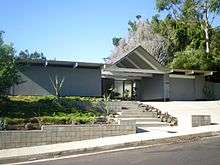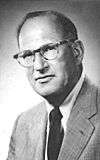Joseph Eichler
| Joseph L. Eichler | |
|---|---|
|
Joseph Eichler in 1958 | |
| Born |
June 25, 1900 New York City, New York |
| Died |
July 1, 1974 (aged 74) San Mateo County, California |
| Nationality | American |
| Citizenship | United States |
| Occupation | Real estate developer |
| Spouse(s) | Lillian Moncharsh |
| Children | 2 |
Joseph Leopold Eichler (June 25, 1900 – July 1, 1974) was a 20th-century post-war U.S. American real estate developer known for developing distinctive residential subdivisions of Mid-Century modern style tract housing in California, United States. He was one of the influential advocates of bringing modern architecture from custom residences and large corporate buildings to general public availability. His company and developments remain in the Greater San Francisco Bay Area and Greater Los Angeles.[1]
Eichler Homes
Between 1949 and 1966, Joseph Eichler's company, Eichler Homes, built over 11,000[2] homes in nine communities in Northern California and homes in three communities in Southern California. Later, other firms worked with Eichler's company to build similar houses. Together, they all came to be known as Eichlers. During this period, Eichler became one of the nation's most influential builders of modern homes. The largest contiguous Eichler Homes development is "The Highlands" in San Mateo, built between 1956 and 1964.

Joseph Eichler is considered by some to be a social visionary and commissioned designs primarily for middle-class Americans. One of his stated aims was to construct inclusive and diverse planned communities, ideally featuring integrated parks and community centers. Eichler established a non-discrimination policy and offered homes for sale to anyone of any religion or race. In 1958, he resigned from the National Association of Home Builders when they refused to support a non-discrimination policy.
Design
According to his son,[3] Eichler was inspired by a short period of time when the family lived in a Frank Lloyd Wright–designed home in Hillsborough.[4] Eichler was attracted to the style and decided to try to produce similar designs. Joseph Eichler used well-known architects to design both the site plans and the homes themselves. He hired the respected architect and Wright disciple of sorts[5] Robert Anshen of Anshen & Allen to design the initial Eichlers, and the first prototypes were built in 1949.[6] In later years, Eichler built homes that were designed by other architects including by the San Francisco firm Claude Oakland & Associates and the Los Angeles firms of Jones & Emmons, A. Quincy Jones, and Raphael Soriano.
Eichler homes are examples of Modernist architecture that has come to be known as "California Modern", and typically feature glass walls, post-and-beam construction, and open floorplans in a style indebted to Frank Lloyd Wright and Mies van der Rohe. Eichler home exteriors featured flat and/or low-sloping A-framed roofs, vertical 2-inch pattern wood siding, and spartan facades with clean geometric lines. One of Eichler's signature concepts was to "bring the outside in", achieved via skylights and floor-to-ceiling windows with glass transoms looking out on protected and private outdoor rooms, patios, atriums, gardens, and swimming pools. Also of note is that most Eichler homes feature few, if any, front-facing (i.e., street-facing) windows; instead house fronts have either small, ceiling-level windows or small, rectangular windows with frosted glass. Many other architectural designs have large windows on all front-facing rooms.
The interiors had numerous unorthodox and innovative features for the time period including: exposed post-and-beam construction; tongue and groove decking for the ceilings following the roofline; concrete slab floors with integral radiant heating; lauan (Philippine mahogany) paneling; sliding doors for rooms, closets, and cabinets; and typically a second bathroom located in the master bedroom. Later models introduced the distinctive Eichler entry atriums, an open-air, enclosed entrance foyer designed to further advance the concept of integrating outdoor and indoor spaces.
Eichler homes were airy and modern in comparison to most of the mass-produced, middle-class, postwar homes built in the 1950s. At first, potential home buyers, many of whom were war-weary ex-servicemen and women seeking convention rather than innovation, were resistant to the innovative homes. Eichler also faced competition from developers who used stylistic elements of Eichler homes in diluted and more conventional designs, later called "Eichleresque". Eichler Homes never achieved large profits for Joseph Eichler.
Projects
The Northern California Eichler Homes are predominantly in San Francisco, Marin County, Sacramento, the East Bay towns of Walnut Creek, Concord, Oakland, Castro Valley, and the San Francisco Peninsula towns of San Mateo, Redwood City, Palo Alto, Sunnyvale, Mountain View and San Jose. The Southern California Eichler Homes developments are in Thousand Oaks, Granada Hills, Orange and Palm Springs.
Eichler Homes neighborhoods
- Lucas Valley and Marinwood – Marin County, California
- The Terra Linda section – San Rafael, California
- 19th Avenue Park - San Mateo, California[7]
- The Highlands – San Mateo, California - With over 700 Eichlers, this is the largest contiguous development of Eichler homes.
- Mills Estates - Burlingame, California
- Atherwood – Redwood City, California
- Monta Loma Neighborhood – Mountain View, California[8]
- Stanford University - Stanford, California, about 100 homes on Stanford land north of Page Mill Road and east of Junipero Serra Blvd.
- Midtown – South Palo Alto Palo Alto, California, with many Eichler Homes, a Swim and Tennis Club called "Eichler" and an Eichler Tract Community Association and Aquatic Facility called "Greenmeadow"
- Fairgrove Tract – Cupertino, California has 229 homes built in 1960–1961
- Fairwood, Fairbrae, and Fairbrae addition – Sunnyvale, California have 400+ homes built between 1958–1961
- Fairglen Tract in the Willow Glen neighborhood – San Jose, California
- Morepark Neighborhood (currently called Rose Glen / Sherman Oaks) Willow Glen - San Jose, California
- Clay Drive - Los Altos, California
- Concord, California – Three Eichler tracts (Rancho Del Diablo, Rancho Los Santos, and Parkwood Estates) consisting of approximately 175 homes built between 1963 and 1964
- Rancho San Miguel in Walnut Creek, California – A neighborhood with more than 300 Eichler homes
- Greenridge Road area of Castro Valley, California has a large development of Eichler homes[9]
- South Land Park and South Land Park Hills are neighborhoods in Sacramento, California, with many Eichler homes and a street named Eichler Street
- Thousand Oaks, California – Eichler community in the Conejo Valley
- Granada Hills, California – Eichler community in the San Fernando Valley; its "Foster Residence" is a designated Los Angeles Historic-Cultural Monument
- Fairhaven – Orange, California, with 140 Eichler homes
- Oakland, California
- Fairmeadow - Orange, California, with 123 Eichler homes
- Fairhills - Villa Park, California, with 80 Eichler homes
- Balboa Heights - Burbank, California, with 109 Eichler homes
- Pomeroy West – Santa Clara, California, with 133 Eichler homes
- Diamond Heights neighborhood - San Francisco, California
- Palm Springs, California in the southernmost Andreas Hills neighborhood. Building started in 2015 based on Eichler's blueprints, built by KUD Development.[10][11]
Other projects
Joseph Eichler also built semi-custom designs for individual clients by commission, such as three in Chestnut Ridge, New York. As a result of soaring land prices in the mid-1960s urban redevelopment projects became popular, and Eichler began building low- and high-rise projects in San Francisco's Western Addition and Hunters Point-Bayview districts, luxury high-rises and clustered housing on Russian Hill and Diamond Heights. He also developed the suburban and trendsetting co-op communities Pomeroy Green and Pomeroy West in Santa Clara. These large projects began to overextend the company, and by the mid-1960s, Eichler Homes was in financial distress. The company filed for bankruptcy in 1967.
Personal life
He married Lilian Moncharsh (1902–1982), the daughter of Polish Jewish emigres.[12] Together they had two sons, Edward "Ned" Philip (1930–2014) and Richard.[13][14]
References
- ↑ Jewish Daily Forward: "How 'Eichlers' Brought Design to Suburbia - Jewish Builder Transformed American Ideal of Modern Homes" By Renee Ghert-Zand March 02, 2012
- ↑ Adamson, Paul (2002). Eichler: Modernism rebuilds the American Dream (first ed.). Gibbs Smith. p. 22. ISBN 1-58685-184-5.
- ↑ O'DELL, LYNN (1993-10-23). "Eichler Influenced by Wright: After Living in a House Designed by the Architect, Eichler Set Out to Build His Own and Never Quit". Los Angeles Times. ISSN 0458-3035. Retrieved 2015-12-27.
- ↑ "The Bazett House - Hillsborough". Eichler Network. Retrieved 2015-12-27.
- ↑ O'DELL, LYNN (1993-10-23). "Eichler Influenced by Wright : After Living in a House Designed by the Architect, Eichler Set Out to Build His Own and Never Quit". Los Angeles Times. ISSN 0458-3035. Retrieved 2015-12-27.
- ↑ "Joe Eichler Profile". Eichler Network. Retrieved 2015-12-27.
- ↑ "Work in Progress: 19th Avenue - San Mateo". Eichler Network. Retrieved 2015-12-27.
- ↑ "Steve Jobs called Mountain View home as a child". Mountain View Voice Newspaper. Retrieved 2015-12-27.
- ↑ Joseph Eichler | Progressive builder of Joseph Eichler Homes | Architect
- ↑ "The First New Eichler Home in 40 Years is Almost Finished". Curbed. 2015-01-20. Retrieved 2016-03-07.
- ↑ "Reborn Eichler". Palm Springs Life. 2015-05-01. Retrieved 2016-03-07.
- ↑ Adamson, Paul and Marty Arbunich Eichler: Modernism Rebuilds the American Dream edited by Marty Arbunich, Ernest Braun | 2002 | p. 44
- ↑ Sheyner, Gennady. "Planned home brings angst to Eichler block in Palo Alto". PaloAltoOnline.com. Retrieved 2016-01-27.
- ↑ "Ned Eichler, son of innovative housing developer, dead at 83". Mercury News. Retrieved 2016-01-27.
Sources
- Adamson, Paul; Marty, Arbunich (2002). Eichler: Modernism Rebuilds the American Dream. Ernest Braun (photographer). Layton, Utah: Gibbs Smith Publishers. ISBN 1-58685-184-5.
- Adamson, Paul (March 2001). "California modernism and the Eichler homes". The Journal of Architecture. 6 (1): 1–25. doi:10.1080/13602360010024804.
- Ditto, Jerry; Lanning, Stern (1995). Design for Living: Eichler Homes. Marvin Wax (photographer). San Francisco: Chronicle Books. ISBN 0-8118-0846-7.
- Jacobs, Karrie (May 15, 2005). "Saving the Tract House". The New York Times Magazine. Retrieved December 26, 2009.
